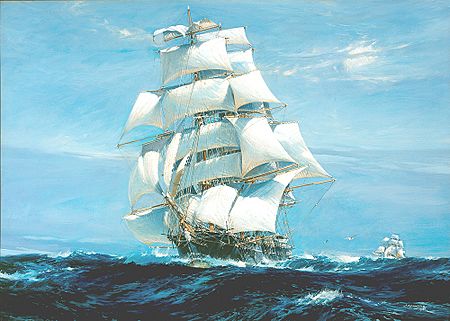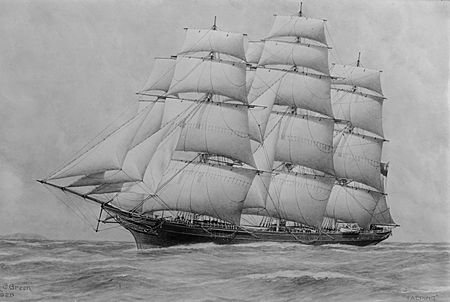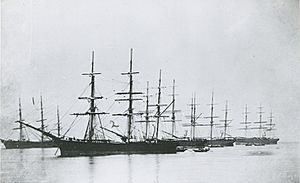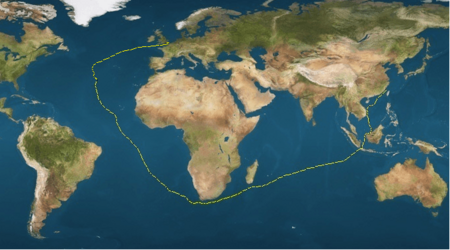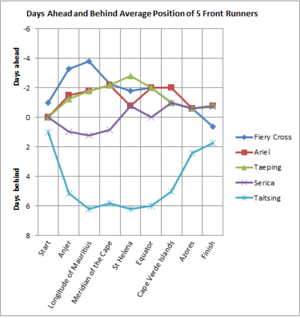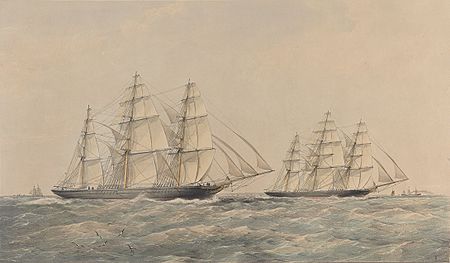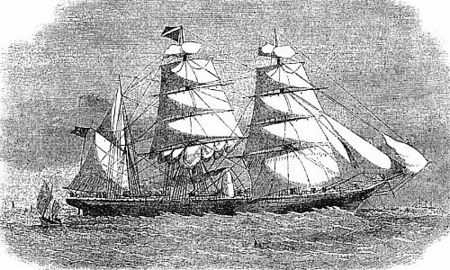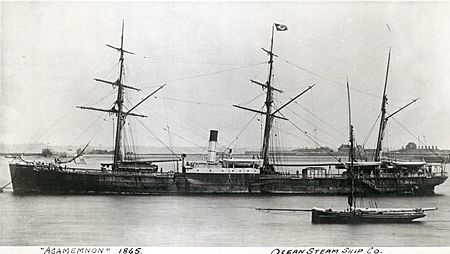Great Tea Race of 1866 facts for kids
Imagine a thrilling race across the world's oceans, not with cars or planes, but with magnificent sailing ships called clippers. These ships were built for speed! In the mid-1800s, they raced to bring the first fresh tea from China to Britain each year. The ship that arrived first could earn a special prize.
The Great Tea Race of 1866 was one of the most exciting. People followed it closely in newspapers. Two ships, Taeping and Ariel, finished incredibly close after sailing over 14,000 miles! Taeping arrived just 28 minutes before Ariel. Another ship, Serica, docked only an hour and 15 minutes after Ariel. These three ships had left China on the same day and arrived in London 99 days later, all on the same tide!
Because the finish was so close, and to avoid any arguments, the prize money was shared between Taeping and Ariel. This was the last time a special prize was offered for the first tea clipper to arrive. Soon, faster steamships and a new shortcut, the Suez Canal, would change ocean travel forever.
Contents
Why Tea Clippers Raced
Tea came to Europe from China a long time ago, but it was a luxury. In the 1800s, more people started drinking tea. Britain was a big market. At first, only one company controlled the tea trade. But when that changed in 1834, many merchants wanted to be first to sell the new tea crop.
This meant they needed faster ships. Clippers were designed for speed, unlike the older, slower ships. A ship known for fast trips could charge more money to carry goods. Tea sellers would even mention which ship brought their tea in advertisements! Even if the very first tea wasn't the best quality, it was exciting because it arrived so quickly.
The Race for Prizes
Being first was very profitable for tea merchants. So, they started offering special prizes. In 1854, a ship called Vision got extra money if it was the first to dock. In 1855, Maury and Lord of the Isles raced for a prize, and Lord of the Isles won because it got a better tugboat to pull it up the river. The prize wasn't just for the fastest sailing; it also depended on how quickly a ship could load its cargo and leave.
In 1861, a prize of 10 shillings per ton was offered. This was won by Fiery Cross, which also won in 1862, 1863, and 1865.
Following the Race
People who loved shipping or business could easily follow the tea clippers' progress in newspapers. There were special "Shipping Intelligence" columns. By 1866, newspapers were full of excitement about the race. They had predictions, updates, and detailed reports. Many people placed bets on which ship would win, from London to Hong Kong! Even the captains and crews bet on their own ships.
Meet the Racers
The tea trade from China was huge. Many ships sailed during the 1866-67 tea season. They left from different ports in China. In May 1866, 16 of the best clippers gathered at Pagoda Anchorage near Foochow (now Fuzhou). The fastest ships were usually loaded first. But sometimes, it depended on the ship's size or the local agent's influence.
Here are the main ships in the 1866 Tea Race:
- Ariel was built in 1865. Many thought she was the fastest of her time. She was designed to sail well in light winds. But in strong storms, her crew had to be careful. She was built with wooden planks on an iron frame, making her very strong and light.
- Fiery Cross had won the tea race four times before (1861, 1862, 1863, 1865). She was an older ship, built in 1860, mostly of wood. But she had new technology, like steel masts and special sails that were easy to roll up.
- Serica was launched in 1863. She was also built by the same company as Ariel. She won the race in 1864.
- Taitsing was another ship built with a composite (wood on iron) design. She was launched in 1865, so this was her first trip to China.
- Taeping was the first composite ship built by her shipyard, launched in 1863. On her first voyage, she lost some masts in a big storm near Taiwan. But after repairs, she made an incredibly fast trip to London in just 89 days!
Getting Ready to Sail
The race wasn't just about sailing fast; it was also about how well the ships were managed in port. Each ship had to be ready to load its tea. First, a layer of clean small stones, called "shingle," was spread on the bottom of the ship. This helped balance the ship.
Tea arrived in special boats called "chop boats." The tea chests were carefully packed into the ship by skilled Chinese workers. They used wood and other materials, called "dunnage," to keep the chests from moving.
Loading was done very quickly. In the 1850s, one ship loaded 8,000 tea chests and over 1,000 bales of silk in just two days!
On May 24th, 1866, the first tea arrived for loading. Ariel was the first to finish loading her huge cargo of over 1.2 million pounds of tea. She was ready to go by the afternoon of May 28th.
Fiery Cross finished next, about 12 hours later. Her captain was so eager to leave that he forgot to finish his paperwork! Taeping and Serica left together, and Taitsing was a day behind them.
Setting Sail
Ariel started raising her anchor at 5 AM on May 29th. A paddle steamer, Island Queen, began towing her down the Min River towards the sea. But the river was tricky, and Ariel had to anchor again to get control. By then, the tide was low, and Ariel was too deep to cross the sandbar.
Captain Keay of Ariel was frustrated when Fiery Cross, with a stronger tug and a shallower bottom, towed right past them and got out to sea! Then, bad weather made it impossible for Ariel to leave on the next tide.
Finally, on the morning of May 30th, Ariel reached the open sea. But Taeping and Serica were only minutes behind her, and Fiery Cross was already 14 hours ahead. After a small delay with the pilot boat, the race was truly on!
Three of the top ships now had a fairly even start. There was a good wind, and they set their biggest sails. Ariel slowly started to catch up to the other two. Soon, the weather turned rainy, and they lost sight of each other, racing on unseen.
News Travels Fast
News of the race start reached British newspapers by June 11th. The Pall Mall Gazette listed the first four ships that had left. They also mentioned that "betting at Hong Kong runs very high." This news likely traveled quickly by telegraph from Sri Lanka.
Later, on August 10th, more detailed news arrived by mail. It gave the departure dates and when the ships passed Anjer, a key point in Indonesia.
The next big news was when Ariel and Taeping were seen heading up the English Channel. After that, there were many detailed reports about the incredibly close finish.
The Long Journey Home
The route from China to London was long. Ships sailed across the China Sea, then the Indian Ocean, around the southern tip of Africa, and into the Atlantic. They usually passed west of the Azores before turning towards the English Channel.
The total distance from Foochow to London was over 14,000 miles. Ariel actually sailed about 15,800 nautical miles on her 1866 trip!
The start of the tea season in China meant ships faced strong head winds in the China Sea. Captains often sailed west towards the coast of Vietnam to catch helpful "land breezes." This meant sailing close to shore, sometimes in the middle of the night, and avoiding dangerous islands and reefs. From Vietnam, they would head south to Borneo to catch more helpful breezes.
Crossing the China Sea was often the most important part of the journey for the overall speed. It also had many dangers because maps weren't always accurate back then.
All five leading ships in the 1866 race took the route through the Sunda Strait, sailing past the dangerous Paracel Islands, down the coast of Vietnam, and then south to Borneo.
Life at Sea
Even before Ariel left the river, Captain Keay had his crew working to balance the ship. This continued for over two weeks! They moved cargo and heavy items to make the ship steer better and sail faster. This was done while the crew was constantly adjusting sails, fixing things, and keeping the ship running.
Early in the race, Ariel spotted Taeping on June 2nd. They saw her again on June 9th and 10th near Borneo. On the 10th, Taeping signaled that she had passed Fiery Cross two days earlier. This meant Ariel was ahead!
As the ships crossed the Indian Ocean and rounded Africa, the race got even closer. The lead kept changing between the top three ships. Serica caught up a lot by the time they passed St. Helena.
The next time ships saw each other was on August 9th, when Taeping and Fiery Cross exchanged signals in the Atlantic. They stayed together until August 27th, when a breeze helped Taeping pull ahead. Fiery Cross was unlucky and got stuck with no wind for another 24 hours.
The distance between all five ships kept shrinking as they neared the Azores. Ariel, Fiery Cross, Taeping, and Serica all passed Flores Island on August 29th. Taitsing was about two days behind them. The next big goal was entering the English Channel.
The Finish Line!
Ariel saw the Bishop Light (a lighthouse) at 1:30 AM on September 5th, 1866. With all her sails set, she sped towards the English Channel. At sunrise, Captain Keay saw another ship behind them, also with every sail up. He knew it was Taeping!
A strong wind pushed both ships up the Channel at 14 knots (about 16 miles per hour). They passed famous landmarks like The Lizard and Start Point. The two ships stayed incredibly close, with Ariel just barely in the lead.
At 3:00 AM on September 6th, Ariel neared Dungeness and started signaling for a pilot (a local expert who guides ships into port). She stopped and fired flares and rockets. Taeping was coming up fast, also signaling for a pilot. Captain Keay ordered Ariels sails to be filled again to stay ahead and get the first pilot. Taepings captain, MacKinnon, also stopped.
At 5:55 AM, a pilot boarded Ariel. He congratulated Captain Keay for being the first ship from China. But Captain Keay replied, "Yes, and what is that to the westward? We have not room to boast yet." He meant Taeping was still right there!
At 6:00 AM, both ships were moving again, heading for South Foreland. Ariel was about a mile ahead. Then, both ships signaled for a tugboat. Here, Taeping got lucky: she got the better tug, which pulled her into the lead as they were towed into the Thames.
Taeping reached Gravesend about 55 minutes before Ariel. But both ships had to wait for the tide to rise enough to enter their docks. Ariel had a shorter distance to go to the East India Dock. She arrived at 9:00 PM, but the tide was still too low. Taeping went further upriver to London Docks. Her shallower bottom allowed her to get through the outer gates there. She entered at 9:47 PM. Ariel finally entered East India Dock at 10:15 PM.
While Ariel and Taeping were racing up the English coast, Serica was speeding along the French side. She managed to get into the West India Dock at 11:30 PM, just before the gates closed.
So, these three ships, after sailing over 14,000 miles for 99 days, all docked in London on the same tide, less than two hours apart!
Fiery Cross arrived on September 8th, and Taitsing on September 9th.
Sharing the Prize
The clippers in the 1866 tea season had a special prize of 10 shillings per ton written into their shipping papers. This was extra money paid to the first ship to dock. For Ariel, the normal shipping cost was £5 per ton. A "ton" here meant a certain volume of space in the ship, not weight.
Normally, this extra prize money was worth it because the first tea of the season sold for a lot. But in 1866, there was a problem. The first tea cargo had already arrived two weeks earlier on a steamship called Erl King, which wasn't part of the race. This meant the tea merchants would lose money. Plus, with three clippers arriving so close together, there would be too much new tea, making prices fall even more.
The owners of Ariel and Taeping knew this. As soon as their ships signaled from the Downs (a famous anchorage), they worried that the merchants might say the race was a tie or that there was no clear winner, and refuse to pay the prize. So, they made a deal: whichever ship docked first would claim the prize, and the other wouldn't argue. In return, they would share the prize money equally. The captains, MacKinnon and Keay, also shared the £100 prize for the winning captain. This is exactly what happened: Taeping claimed the prize, and the money was split with Ariel.
After the 1866 race, the special prize for the first tea clipper to arrive in London was stopped.
The End of an Era
As Ariel and the other clippers left China in May 1866, the steamship Erl King was loading tea. She sailed on June 5th, just 7 days after Fiery Cross. Erl King arrived in London on August 22nd, only 78 days after sailing. She was in London 15 days before the first clippers! Taeping, for example, took 99 days. Newspapers in places like Glasgow and Liverpool (where many steamships were built) started saying that steamships would soon take over the tea trade.
Newspapers also talked about the SS Agamemnon, a true steamship (not just an auxiliary one like Erl King). Agamemnon had just made a record-breaking trip to China in 65 days. She was on her way back with a huge cargo of tea. She used much less coal than other steamships, making her very efficient. Her owners were so confident that they were building two more ships just like her!
The opening of the Suez Canal in 1869 was a game-changer. It cut the distance from China to London by about 3,250 nautical miles (nearly a quarter shorter!). While sailing ships could be towed through the canal, it was difficult and expensive. Also, the winds in the Red Sea (part of the canal route) were not good for clippers. So, clippers still had to sail all the way around Africa.
When tea clippers arrived in China in 1870, they found many more steamships. Steamers were in high demand, and they could charge almost twice as much to carry tea to London. Also, insuring tea on a steamer was much cheaper than on a sailing ship. Steamers using the Suez Canal were so successful that 45 were built in just one area of Scotland in 1871 for the Far East trade.
As more steamers appeared, clippers had to find other types of work. To save money, they carried fewer crew members. Many ships even had their sails changed to a simpler "barque" style, which needed a smaller crew. The last famous race between tea clippers was between Thermopylae and Cutty Sark in 1872.
What Happened Next
Erl King was the first ship to carry tea through the Suez Canal, arriving in London in 1870. She later worked on routes to Australia and across the Atlantic. She was lost off Florida in 1891.
Captain MacKinnon of Taeping became ill on his next trip and died while traveling home. Taeping was wrecked in the China Sea in 1871.
Captain Keay left Ariel in 1868. Ariel disappeared on a trip from London to Australia in 1872. Many believe she was hit by a huge wave from behind, which was a risk for her design.
Serica was wrecked on the Paracel Islands in 1872, with only one person surviving.
Fiery Cross carried her last tea cargo in 1872-73. She continued in other trade until she was lost in the late 1880s or early 1890s.
Taitsing continued in the China trade, carrying her last tea cargo in 1874-75. She was lost in 1883.
The Cutty Sark, built in 1869, is one of the last remaining physical reminders of the amazing tea clipper era, which was highlighted by the Great Tea Race of 1866.
|


